Lethbridge College: Social Media's Influence on Social Interaction
VerifiedAdded on 2023/01/20
|7
|1491
|75
Report
AI Summary
This report, likely submitted for a psychology course, investigates the multifaceted impacts of social media on human interaction. It explores the negative consequences of increased digital communication, such as reduced face-to-face interaction and potential cyberbullying, drawing on research to support these claims. The report also examines the therapeutic effects of online communication, particularly for adolescents, highlighting how social media can foster social support and a sense of community. Furthermore, it analyzes how the presence of mobile devices and social media affects the quality of in-person interactions, potentially diminishing intimacy and empathy. The conclusion acknowledges both the benefits and risks of social media, emphasizing the importance of mindful usage to maintain healthy relationships and overall well-being, referencing studies to support its findings.
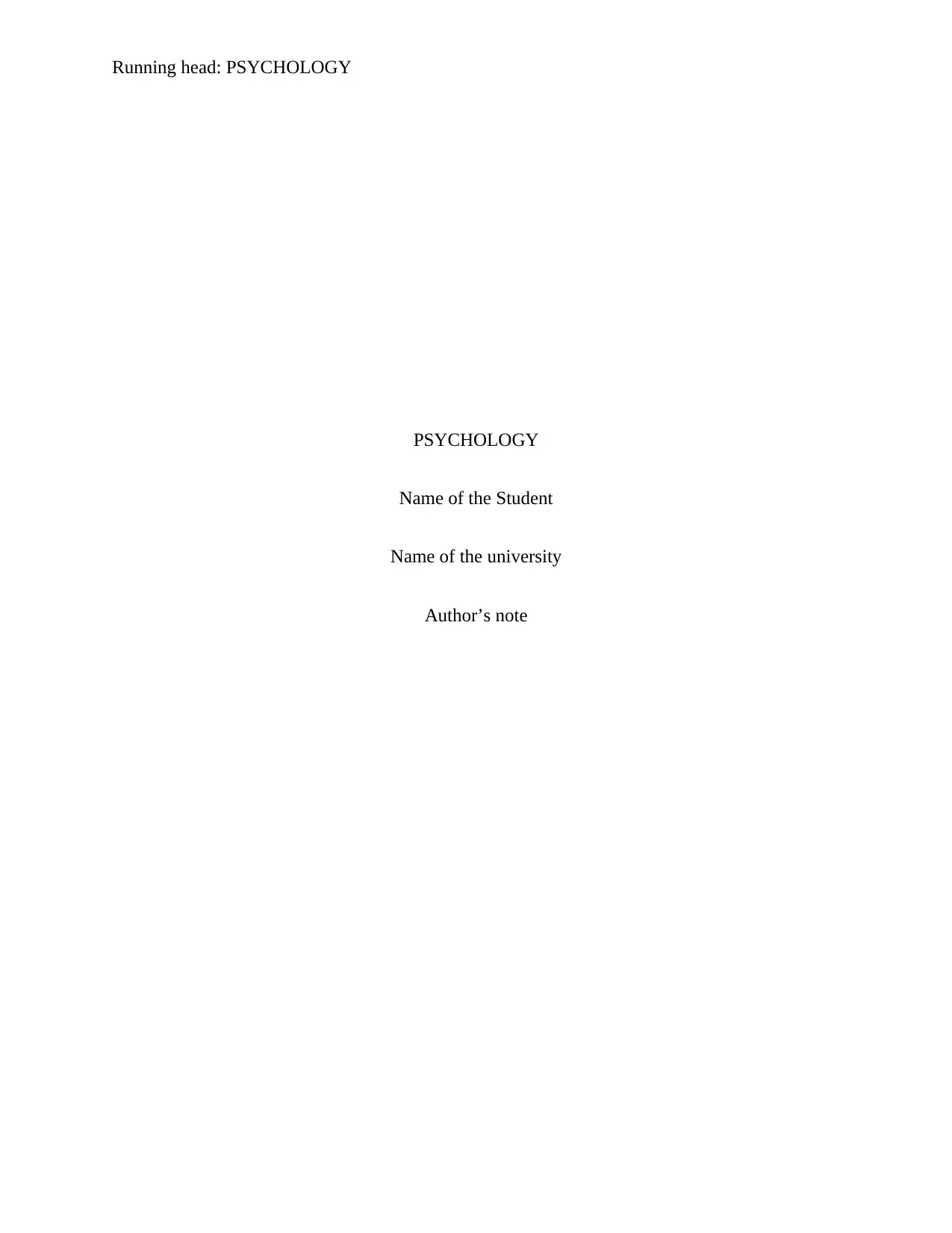
Running head: PSYCHOLOGY
PSYCHOLOGY
Name of the Student
Name of the university
Author’s note
PSYCHOLOGY
Name of the Student
Name of the university
Author’s note
Paraphrase This Document
Need a fresh take? Get an instant paraphrase of this document with our AI Paraphraser

1PSYCHOLOGY
How has modern social media changed social interaction?
Introduction
How does social media affect human interaction? Will direct interaction diminish due to the
advent of the new machineries? Social competency can be termed as an important ideal that most
people uses to strive forward, but there is an evidence claiming that it is actually harming the
ability of the people to interact in an offline setting. The main aim of this paper is to find out how
has modern social media changed social interaction? In order to answer these question we will
have to answer these associated questions- what are the negative impacts of social media in
relation to relational communication? Is there any therapeutic effect of online communication?
How social networking does affects face to face interaction?
Negative Impact of social media in the interpersonal communication
Social media has affected several areas of contemporary life and has impacted the
modern life of people and personal interaction profoundly. The present-day is characterised by
lack of time as in most of the cases most of the family members’ remains employed for having a
satisfactory life style, with no time for interaction among one another (Subramanian, 2017).
Nowadays, time has become a very valuable resources. Using social media for communicating
with the production of mobile or digital equipment have fulfilling the social needs has become an
important media for the communication. It is evident from the paper, digitalisation has decreased
the face to face communication between humans, and be it for the advertising of for the
promotion of a product.
How has modern social media changed social interaction?
Introduction
How does social media affect human interaction? Will direct interaction diminish due to the
advent of the new machineries? Social competency can be termed as an important ideal that most
people uses to strive forward, but there is an evidence claiming that it is actually harming the
ability of the people to interact in an offline setting. The main aim of this paper is to find out how
has modern social media changed social interaction? In order to answer these question we will
have to answer these associated questions- what are the negative impacts of social media in
relation to relational communication? Is there any therapeutic effect of online communication?
How social networking does affects face to face interaction?
Negative Impact of social media in the interpersonal communication
Social media has affected several areas of contemporary life and has impacted the
modern life of people and personal interaction profoundly. The present-day is characterised by
lack of time as in most of the cases most of the family members’ remains employed for having a
satisfactory life style, with no time for interaction among one another (Subramanian, 2017).
Nowadays, time has become a very valuable resources. Using social media for communicating
with the production of mobile or digital equipment have fulfilling the social needs has become an
important media for the communication. It is evident from the paper, digitalisation has decreased
the face to face communication between humans, and be it for the advertising of for the
promotion of a product.
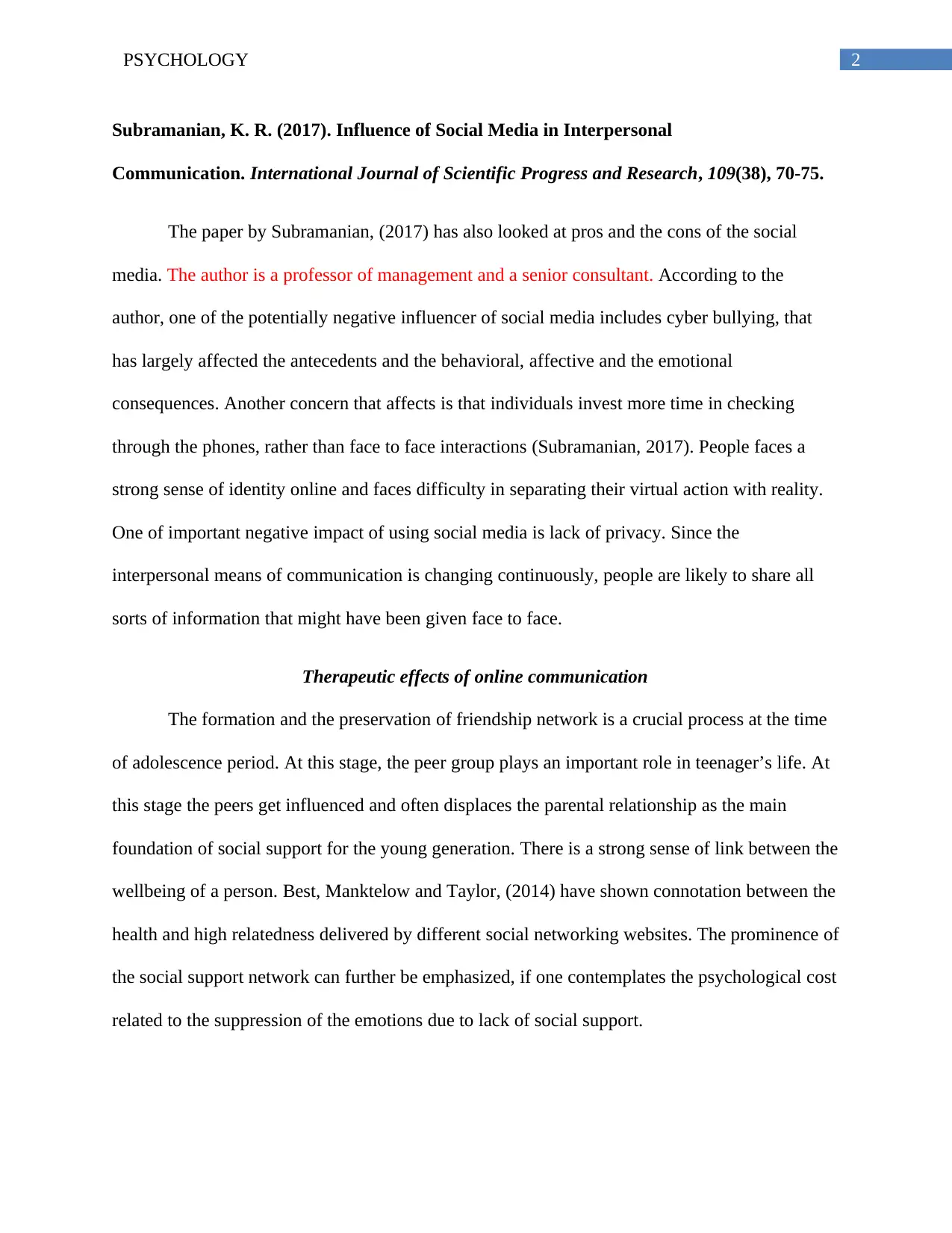
2PSYCHOLOGY
Subramanian, K. R. (2017). Influence of Social Media in Interpersonal
Communication. International Journal of Scientific Progress and Research, 109(38), 70-75.
The paper by Subramanian, (2017) has also looked at pros and the cons of the social
media. The author is a professor of management and a senior consultant. According to the
author, one of the potentially negative influencer of social media includes cyber bullying, that
has largely affected the antecedents and the behavioral, affective and the emotional
consequences. Another concern that affects is that individuals invest more time in checking
through the phones, rather than face to face interactions (Subramanian, 2017). People faces a
strong sense of identity online and faces difficulty in separating their virtual action with reality.
One of important negative impact of using social media is lack of privacy. Since the
interpersonal means of communication is changing continuously, people are likely to share all
sorts of information that might have been given face to face.
Therapeutic effects of online communication
The formation and the preservation of friendship network is a crucial process at the time
of adolescence period. At this stage, the peer group plays an important role in teenager’s life. At
this stage the peers get influenced and often displaces the parental relationship as the main
foundation of social support for the young generation. There is a strong sense of link between the
wellbeing of a person. Best, Manktelow and Taylor, (2014) have shown connotation between the
health and high relatedness delivered by different social networking websites. The prominence of
the social support network can further be emphasized, if one contemplates the psychological cost
related to the suppression of the emotions due to lack of social support.
Subramanian, K. R. (2017). Influence of Social Media in Interpersonal
Communication. International Journal of Scientific Progress and Research, 109(38), 70-75.
The paper by Subramanian, (2017) has also looked at pros and the cons of the social
media. The author is a professor of management and a senior consultant. According to the
author, one of the potentially negative influencer of social media includes cyber bullying, that
has largely affected the antecedents and the behavioral, affective and the emotional
consequences. Another concern that affects is that individuals invest more time in checking
through the phones, rather than face to face interactions (Subramanian, 2017). People faces a
strong sense of identity online and faces difficulty in separating their virtual action with reality.
One of important negative impact of using social media is lack of privacy. Since the
interpersonal means of communication is changing continuously, people are likely to share all
sorts of information that might have been given face to face.
Therapeutic effects of online communication
The formation and the preservation of friendship network is a crucial process at the time
of adolescence period. At this stage, the peer group plays an important role in teenager’s life. At
this stage the peers get influenced and often displaces the parental relationship as the main
foundation of social support for the young generation. There is a strong sense of link between the
wellbeing of a person. Best, Manktelow and Taylor, (2014) have shown connotation between the
health and high relatedness delivered by different social networking websites. The prominence of
the social support network can further be emphasized, if one contemplates the psychological cost
related to the suppression of the emotions due to lack of social support.
⊘ This is a preview!⊘
Do you want full access?
Subscribe today to unlock all pages.

Trusted by 1+ million students worldwide
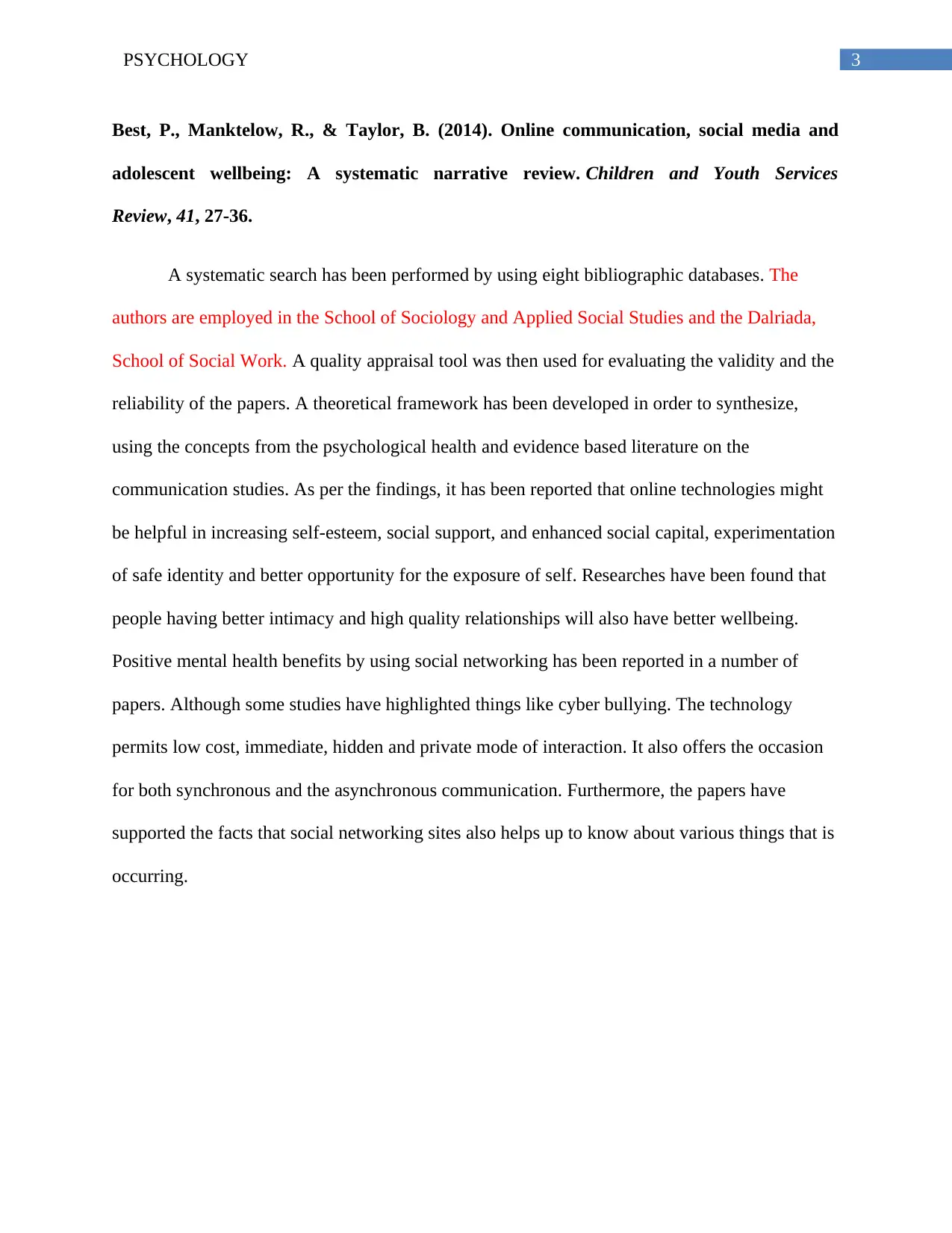
3PSYCHOLOGY
Best, P., Manktelow, R., & Taylor, B. (2014). Online communication, social media and
adolescent wellbeing: A systematic narrative review. Children and Youth Services
Review, 41, 27-36.
A systematic search has been performed by using eight bibliographic databases. The
authors are employed in the School of Sociology and Applied Social Studies and the Dalriada,
School of Social Work. A quality appraisal tool was then used for evaluating the validity and the
reliability of the papers. A theoretical framework has been developed in order to synthesize,
using the concepts from the psychological health and evidence based literature on the
communication studies. As per the findings, it has been reported that online technologies might
be helpful in increasing self-esteem, social support, and enhanced social capital, experimentation
of safe identity and better opportunity for the exposure of self. Researches have been found that
people having better intimacy and high quality relationships will also have better wellbeing.
Positive mental health benefits by using social networking has been reported in a number of
papers. Although some studies have highlighted things like cyber bullying. The technology
permits low cost, immediate, hidden and private mode of interaction. It also offers the occasion
for both synchronous and the asynchronous communication. Furthermore, the papers have
supported the facts that social networking sites also helps up to know about various things that is
occurring.
Best, P., Manktelow, R., & Taylor, B. (2014). Online communication, social media and
adolescent wellbeing: A systematic narrative review. Children and Youth Services
Review, 41, 27-36.
A systematic search has been performed by using eight bibliographic databases. The
authors are employed in the School of Sociology and Applied Social Studies and the Dalriada,
School of Social Work. A quality appraisal tool was then used for evaluating the validity and the
reliability of the papers. A theoretical framework has been developed in order to synthesize,
using the concepts from the psychological health and evidence based literature on the
communication studies. As per the findings, it has been reported that online technologies might
be helpful in increasing self-esteem, social support, and enhanced social capital, experimentation
of safe identity and better opportunity for the exposure of self. Researches have been found that
people having better intimacy and high quality relationships will also have better wellbeing.
Positive mental health benefits by using social networking has been reported in a number of
papers. Although some studies have highlighted things like cyber bullying. The technology
permits low cost, immediate, hidden and private mode of interaction. It also offers the occasion
for both synchronous and the asynchronous communication. Furthermore, the papers have
supported the facts that social networking sites also helps up to know about various things that is
occurring.
Paraphrase This Document
Need a fresh take? Get an instant paraphrase of this document with our AI Paraphraser

4PSYCHOLOGY
Social media affects the quality of the face to face interaction
Current progresses in the technologies for communication have facilitated billions of
people to interact among themselves. It helps the developing the world to connect with others by
the use of mobile phones. The wide spread variety of the mobile phones means that they are
commonly accessible in public and private spaces. Most of the researches on the mobile phones
have suggested the potential capacity of the phone to provide a continuous sense of connection
and wellbeing, a sensation that even continues even in it is in a “silent mode” (Przybylski, &
Weinstein, 2013). The presence of the cell phones are also felt during any social outing. For
example, a large number of couples spending time together or dining, repeatedly intrude their
interactions to check a voice or text message. A large number of survey data have shown that
mobile phones can influence the people connected by a social networks. It can be stated that
proper access to a mobile phone might familiarize an individual to think about other individuals
and proceedings beyond their immediate social context.
Przybylski, A. K., & Weinstein, N. (2013). Can you connect with me now? How the
presence of mobile communication technology influences face-to-face conversation
quality. Journal of Social and Personal Relationships, 30(3), 237-246.
The author is currently employed in the Department of Psychology, University of Essex.
This paper is a randomized controlled trial where twenty four participants have been randomly
assigned to conditions like phone absent and phone present. As per the findings, it was found that
the technology might interfere with the formation of the human relationship (Przybylski, &
Weinstein, 2013). The experiment has indicated that the presence of mobile phones limits the
Social media affects the quality of the face to face interaction
Current progresses in the technologies for communication have facilitated billions of
people to interact among themselves. It helps the developing the world to connect with others by
the use of mobile phones. The wide spread variety of the mobile phones means that they are
commonly accessible in public and private spaces. Most of the researches on the mobile phones
have suggested the potential capacity of the phone to provide a continuous sense of connection
and wellbeing, a sensation that even continues even in it is in a “silent mode” (Przybylski, &
Weinstein, 2013). The presence of the cell phones are also felt during any social outing. For
example, a large number of couples spending time together or dining, repeatedly intrude their
interactions to check a voice or text message. A large number of survey data have shown that
mobile phones can influence the people connected by a social networks. It can be stated that
proper access to a mobile phone might familiarize an individual to think about other individuals
and proceedings beyond their immediate social context.
Przybylski, A. K., & Weinstein, N. (2013). Can you connect with me now? How the
presence of mobile communication technology influences face-to-face conversation
quality. Journal of Social and Personal Relationships, 30(3), 237-246.
The author is currently employed in the Department of Psychology, University of Essex.
This paper is a randomized controlled trial where twenty four participants have been randomly
assigned to conditions like phone absent and phone present. As per the findings, it was found that
the technology might interfere with the formation of the human relationship (Przybylski, &
Weinstein, 2013). The experiment has indicated that the presence of mobile phones limits the
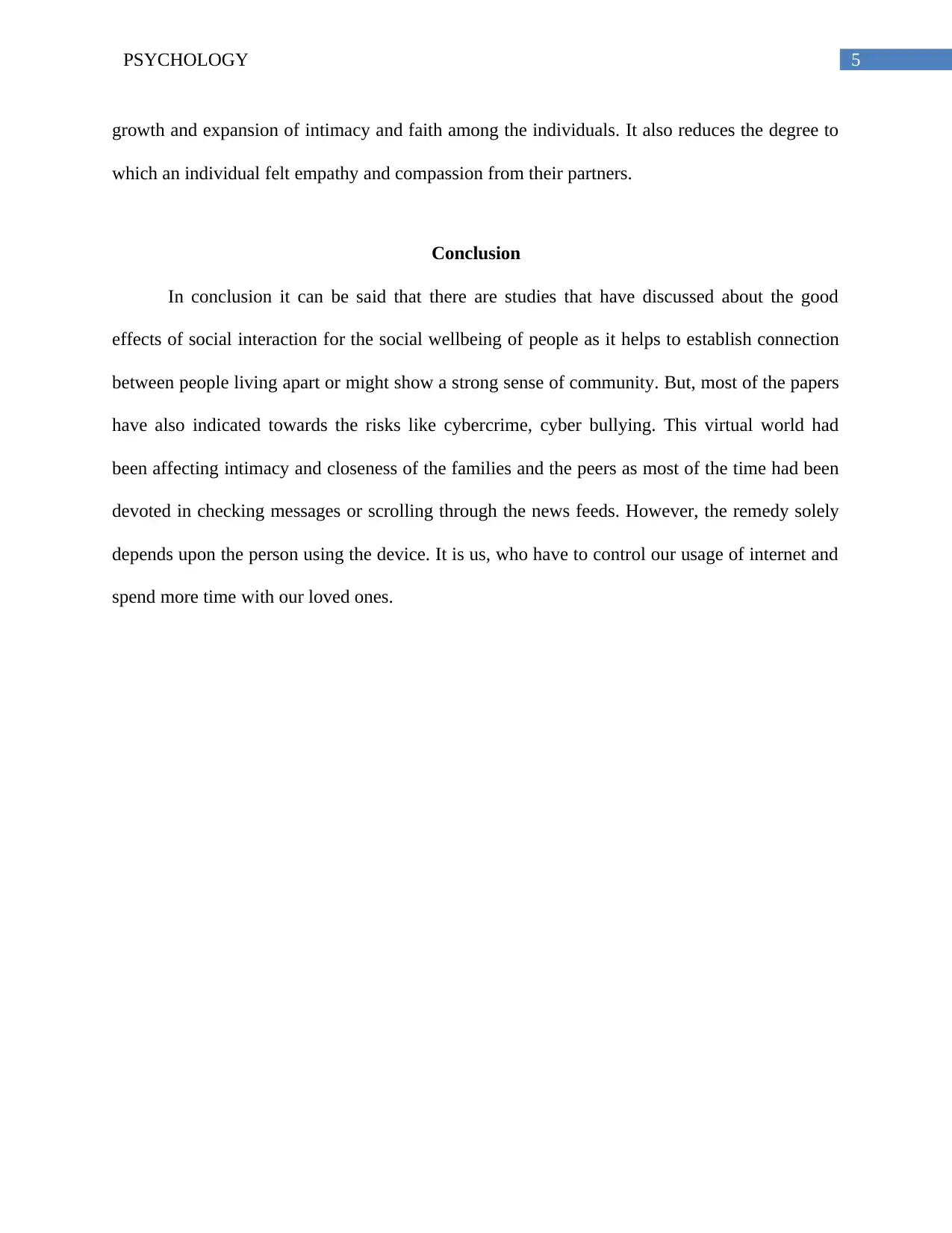
5PSYCHOLOGY
growth and expansion of intimacy and faith among the individuals. It also reduces the degree to
which an individual felt empathy and compassion from their partners.
Conclusion
In conclusion it can be said that there are studies that have discussed about the good
effects of social interaction for the social wellbeing of people as it helps to establish connection
between people living apart or might show a strong sense of community. But, most of the papers
have also indicated towards the risks like cybercrime, cyber bullying. This virtual world had
been affecting intimacy and closeness of the families and the peers as most of the time had been
devoted in checking messages or scrolling through the news feeds. However, the remedy solely
depends upon the person using the device. It is us, who have to control our usage of internet and
spend more time with our loved ones.
growth and expansion of intimacy and faith among the individuals. It also reduces the degree to
which an individual felt empathy and compassion from their partners.
Conclusion
In conclusion it can be said that there are studies that have discussed about the good
effects of social interaction for the social wellbeing of people as it helps to establish connection
between people living apart or might show a strong sense of community. But, most of the papers
have also indicated towards the risks like cybercrime, cyber bullying. This virtual world had
been affecting intimacy and closeness of the families and the peers as most of the time had been
devoted in checking messages or scrolling through the news feeds. However, the remedy solely
depends upon the person using the device. It is us, who have to control our usage of internet and
spend more time with our loved ones.
⊘ This is a preview!⊘
Do you want full access?
Subscribe today to unlock all pages.

Trusted by 1+ million students worldwide
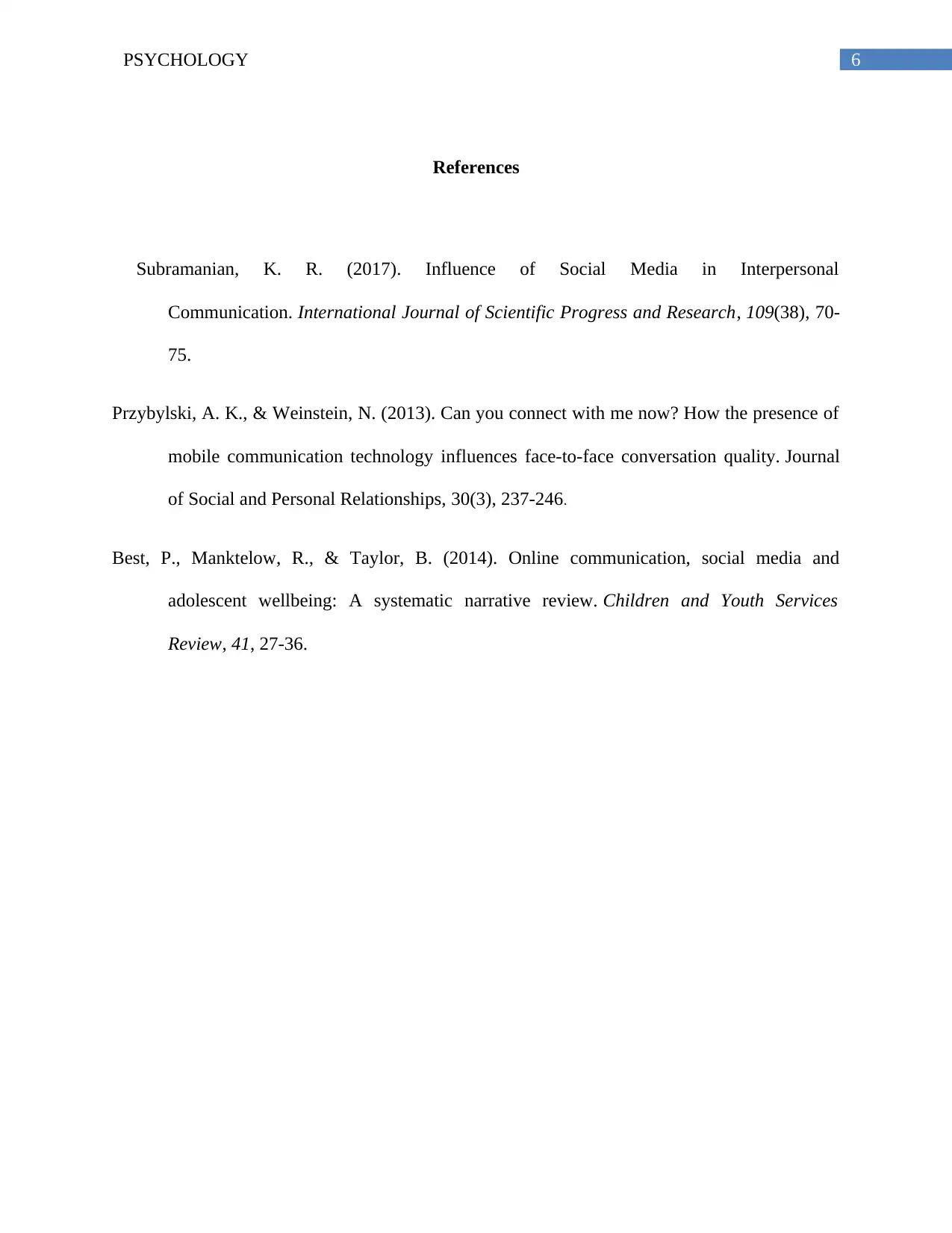
6PSYCHOLOGY
References
Subramanian, K. R. (2017). Influence of Social Media in Interpersonal
Communication. International Journal of Scientific Progress and Research, 109(38), 70-
75.
Przybylski, A. K., & Weinstein, N. (2013). Can you connect with me now? How the presence of
mobile communication technology influences face-to-face conversation quality. Journal
of Social and Personal Relationships, 30(3), 237-246.
Best, P., Manktelow, R., & Taylor, B. (2014). Online communication, social media and
adolescent wellbeing: A systematic narrative review. Children and Youth Services
Review, 41, 27-36.
References
Subramanian, K. R. (2017). Influence of Social Media in Interpersonal
Communication. International Journal of Scientific Progress and Research, 109(38), 70-
75.
Przybylski, A. K., & Weinstein, N. (2013). Can you connect with me now? How the presence of
mobile communication technology influences face-to-face conversation quality. Journal
of Social and Personal Relationships, 30(3), 237-246.
Best, P., Manktelow, R., & Taylor, B. (2014). Online communication, social media and
adolescent wellbeing: A systematic narrative review. Children and Youth Services
Review, 41, 27-36.
1 out of 7
Related Documents
Your All-in-One AI-Powered Toolkit for Academic Success.
+13062052269
info@desklib.com
Available 24*7 on WhatsApp / Email
![[object Object]](/_next/static/media/star-bottom.7253800d.svg)
Unlock your academic potential
Copyright © 2020–2025 A2Z Services. All Rights Reserved. Developed and managed by ZUCOL.





